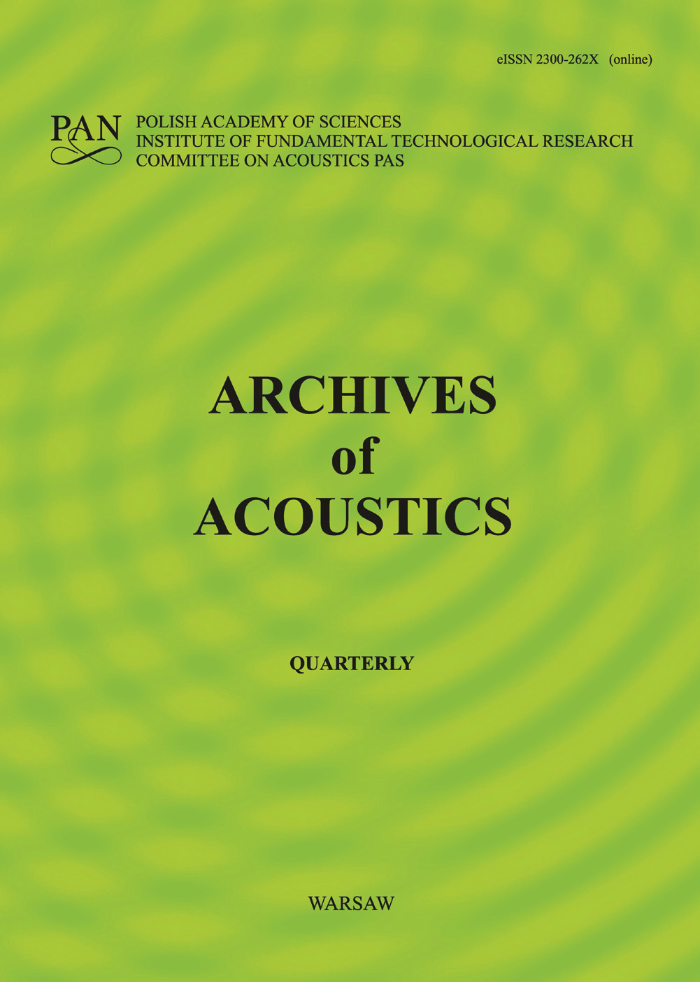Experimental Results of Diver Detection in Harbor Environments Using Single Acoustic Vector Sensor
Abstract
This paper addresses the detection of divers with an open-circuit scuba. An acoustic vector sensor (AVS), which contains four channels, one for the pressure component, and three for orthogonal particle velocity components is proposed to be used. A novel covariance matrix analysis (CMA) method is presented for estimating the signal power using AVS in three-dimensional measurements. This method is based on solving a quartic equation that relates the determinant and trace of the AVS covariance matrix to the reciprocal of the signalto-noise ratio (SNR) in a three-dimensional isotropic acoustic field with spherical isotropic noise. This method is compared with two traditional methods: the AVS pressure channel power, and the minimum variance distortionless response (MVDR) beamformer, in estimating the acoustic power associated with the diver’s breathing. Experimental data from sea trials demonstrate the capability of all three methods to reconstruct the waveform of the acoustic diver signal and highlight the periodic breathing patterns. The diver’s breathing rate and corresponding power are estimated using the fast Fourier transform (FFT) of the power signal, therefore serving as a key signature for diver detection. The experiment demonstrates that the CMA method gives better diver detection index compared to the other two methods.Keywords:
scuba diver, acoustic vector sensor (AVS), detection, minimum variance distortionless response (MVDR), signal-to-noise ratio (SNR), covariance matrix analysis (CMA), fast Fourier transform (FFT)References
1. Abraham D.A. (2019), Underwater Acoustic Signal Processing: Modeling, Detection, and Estimation, Springer, USA.
2. Bereketli A., Guldogan M.B., Kolcak T., Gudu T., Avsar A. (2015), Experimental results for direction of arrival estimation with a single acoustic vector sensor in shallow water, Journal of Sensors, 2015(1): 1–9, https://doi.org/10.1155/2015/401353.
3. Cao J., Liu J., Wang J., Lai X. (2017), Acoustic vector sensor: Reviews and future perspectives, IET Signal Processing, 11(1): 1–9, https://doi.org/10.1049/iet-spr.2016.0111.
4. Chen Y., Wang W., Wang Z., Xia B. (2018), A source counting method using acoustic vector sensor based on sparse modeling of DOA histogram, IEEE Signal Processing Letters, 26(1): 69–73, https://doi.org/10.1109/LSP.2018.2879547.
5. Chen Y., Zhang G., Wang R., Rong H., Yang B. (2023), Acoustic vector sensor multi-source detection based on multimodal fusion, Sensors, 23(3): 1301, https://doi.org/10.3390/s23031301.
6. Chung K.W., Li H., Sutin A. (2007), A frequency-domain multi-band matched-filter approach to passive diver detection, [in:] 2007 Conference Record of the Forty-First Asilomar Conference on Signals, Systems and Computers, pp. 1252–1256, https://doi.org/10.1109/ACSSC.2007.4487426.
7. Dong H., Suo J., Zhu Z., Li S. (2024), Improved underwater single-vector acoustic DOA estimation via vector convolution preprocessing, Electronics, 13(9): 1796, https://doi.org/10.3390/electronics13091796.
8. Donskoy D.M., Sedunov N.A., Tsionskiy M.A. (2008), Variability of SCUBA diver’s acoustic emission, [in:] Optics and Photonics in Global HomelandSecurity IV, pp. 272–282, https://doi.org/10.1117/12.783500.
9. Gorovoy S. et al. (2014), A possibility to use respiratory noises for diver detection and monitoring physiologic status, [in:] Proceedings of Meetings on Acoustics, 21(1): 070007, https://doi.org/10.1121/1.4893767.
10. Gorovoy S. et al. (2015), Detecting respiratory noises of diver equipped with rebreather in water, [in:] Proceedings of Meetings on Acoustics, 24(1): 070020, https://doi.org/10.1121/2.0000171.
11. Gray M., Rogers P.H., Zeddies D.G. (2016), Acoustic particle motion measurement for bioacousticians?: Principles and pitfalls, [in:] Fourth International Conference on the Effects of Noise on Aquatic Life, 27(1): 010022, https://doi.org/10.1121/2.0000290.
12. Hari V.N., Chitre M., Too Y.M., Pallayil V. (2015), Robust passive diver detection in shallow ocean, [in:] OCEANS 2015 – Genova, pp. 1–6, https://doi.org/10.1109/OCEANS-Genova.2015.7271656.
13. Jin B., Xu G. (2020), A passive detection method of divers based on deep learning, [in:] 2020 IEEE 3rd International Conference on Electronics Technology (ICET), pp. 650–655, https://doi.org/10.1109/ICET49382.2020.9119556.
14. Johansson A.T., Lennartsson R.K., Nolander E., Petrović S. (2010), Improved passive acoustic detection of divers in harbor environments using prewhitening, [in:] OCEANS 2010 MTS/IEEE SEATTLE, pp. 1–6, https://doi.org/10.1109/OCEANS.2010.5664549.
15. Korenbaum V., Kostiv A., Gorovoy S., Dorozhko V., Shiryaev A. (2020), Underwater noises of open-circuit scuba diver, Archives of Acoustics, 45(2): 349–357, https://doi.org/10.24425/aoa.2020.133155.
16. Korenbaum V.I. et al. (2016), The possibility of passive acoustic monitoring of a scuba diver, Doklady Earth Sciences, 466(2): 187–190, https://doi.org/10.1134/S1028334X16020136.
17. Lennartsson R.K., Dalberg E., Persson L., Petrović S. (2009), Passive acoustic detection and classification of divers in harbor environments, [in:] OCEANS 2009, pp. 1–7, https://doi.org/10.23919/OCEANS.2009.5422407.
18. Levin D., Habets E.A.P., Gannot S. (2012), Maximum likelihood estimation of direction of arrival using an acoustic vector-sensor, The Journal of the Acoustical Society of America, 131(2): 1240–1248, https://doi.org/10.1121/1.3676699.
19. Li S., Hu B., Zhou W., Zhao L. (2015), Experimental study for feature extraction of diver with atmospheric diving suit, [in:] OCEANS 2015-MTS/IEEE Washington, pp. 1–5, https://doi.org/10.23919/OCEANS.2015.7401820.
20. Liu A., Yang D., Shi S., Zhu Z., Li Y. (2019), Augmented subspace MUSIC method for DOA estimation using acoustic vector sensor array, IET Radar, Sonar and Navigation, 13(6): 969–975, https://doi.org/10.1049/iet-rsn.2018.5440.
21. Ma L., Gulliver T.A., Zhao A., Ge C., Bi X. (2019), Underwater broadband source detection using an acoustic vector sensor with an adaptive passive matched filter, Applied Acoustics, 148: 162–174, https://doi.org/10.1016/j.apacoust.2018.12.023.
22. Nagananda K.G., Anand G.V. (2017), Underwater target tracking with vector sensor array using acoustic field measurements, [in:] OCEANS 2017 – Aberdeen, pp. 1–10, https://doi.org/10.1109/OCEANSE.2017.8084844.
23. Nedelec S.L. et al. (2021), Best practice guide for underwater particle motion measurement for biological applications, Technical report by the University of Exeter for the IOGP Marine Sound and Life Joint Industry Programme, https://www.researchgate.net/publication/356911609.
24. Nehorai A., Paldi E. (1994), Acoustic vector-sensor array processing, [in:] IEEE Transactions on Signal Processing, 42(9): 2481–2491, https://doi.org/10.1109/78.317869.
25. Paulraj A., Roy R., Kailath T. (1985), Estimation of signal parameters via rotational invariance techniques – Esprit, Nineteeth Asilomar Conference on Circuits, Systems and Computers, pp. 83–89, https://doi.org/10.1109/ACSSC.1985.671426.
26. Prodanov E.M. (2021), Classification of the real roots of the quartic equation and their pythagorean tunes, International Journal of Applied and Computational Mathematics, 7(6): 1–14, https://doi.org/10.1007/s40819-021-01152-w.
27. Roh T. et al. (2022), Fabrication and underwater testing of a vector hydrophone comprising a triaxial piezoelectric accelerometer and spherical hydrophone, Sensors, 22(24): 9796, https://doi.org/10.3390/s22249796.
28. Sun G., Yang D., Zhang L., Shi S. (2003), Maximum likelihood ratio detection and maximum likelihood DOA estimation based on the vector hydrophone [in Chinese], Acta Acustica, 28(1): 66–72, https://doi.org/10.15949/j.cnki.0371-0025.2003.01.013.
29. Sutin A., Salloum H., DeLorme M., Sedunov N., Sedunov A., Tsionskiy M. (2013), Stevens passive acoustic system for surface and underwater threat detection, [in:] 2013 IEEE International Conference on Technologies for Homeland Security (HST), pp. 195–200, https://doi.org/10.1109/THS.2013.6698999.
30. Tichavsky P., Wong K.T., Zoltowski M.D. (2001), Near-field/far-field azimuth and elevation angle estimation using a single vector hydrophone, [in:] IEEE Transactions on Signal Processing, 49(11): 2498–2510, https://doi.org/10.1109/78.960397.
31. Tu Q., Yuan F., Yang W., Cheng E. (2020), An approach for diver passive detection based on the established model of breathing sound emission, Journal of Marine Science and Engineering, 8(1): 44, https://doi.org/10.3390/JMSE8010044.
32. Van Trees H.L. (2002), Optimum Array Processing: Part IV of Detection, Estimation, and Modulation Theory, pp. 428–709, John Wiley & Sons, https://doi.org/10.1002/0471221104.
33. Wang X., Chen J., Han J., Jiao Y. (2014), Optimization for the direction of arrival estimation based on single acoustic pressure gradient vector sensor, International Journal of Naval Architecture and Ocean Engineering, 6(1): 74–86, https://doi.org/10.2478/ijnaoe-2013-0164.
34. Yuan M., Wang C., Da L., Li Q. (2022), Signal detection method using a single vector hydrophone in ocean acoustics, The Journal of the Acoustical Society of America, 152(2): 789–798, https://doi.org/10.1121/10.0013219.
35. Zhao A., Ma L., Hui J., Zeng C., Bi X. (2018), Open-lake experimental investigation of azimuth angle estimation using a single acoustic vector sensor, Journal of Sensors, 2018(1), https://doi.org/10.1155/2018/4324902.
2. Bereketli A., Guldogan M.B., Kolcak T., Gudu T., Avsar A. (2015), Experimental results for direction of arrival estimation with a single acoustic vector sensor in shallow water, Journal of Sensors, 2015(1): 1–9, https://doi.org/10.1155/2015/401353.
3. Cao J., Liu J., Wang J., Lai X. (2017), Acoustic vector sensor: Reviews and future perspectives, IET Signal Processing, 11(1): 1–9, https://doi.org/10.1049/iet-spr.2016.0111.
4. Chen Y., Wang W., Wang Z., Xia B. (2018), A source counting method using acoustic vector sensor based on sparse modeling of DOA histogram, IEEE Signal Processing Letters, 26(1): 69–73, https://doi.org/10.1109/LSP.2018.2879547.
5. Chen Y., Zhang G., Wang R., Rong H., Yang B. (2023), Acoustic vector sensor multi-source detection based on multimodal fusion, Sensors, 23(3): 1301, https://doi.org/10.3390/s23031301.
6. Chung K.W., Li H., Sutin A. (2007), A frequency-domain multi-band matched-filter approach to passive diver detection, [in:] 2007 Conference Record of the Forty-First Asilomar Conference on Signals, Systems and Computers, pp. 1252–1256, https://doi.org/10.1109/ACSSC.2007.4487426.
7. Dong H., Suo J., Zhu Z., Li S. (2024), Improved underwater single-vector acoustic DOA estimation via vector convolution preprocessing, Electronics, 13(9): 1796, https://doi.org/10.3390/electronics13091796.
8. Donskoy D.M., Sedunov N.A., Tsionskiy M.A. (2008), Variability of SCUBA diver’s acoustic emission, [in:] Optics and Photonics in Global HomelandSecurity IV, pp. 272–282, https://doi.org/10.1117/12.783500.
9. Gorovoy S. et al. (2014), A possibility to use respiratory noises for diver detection and monitoring physiologic status, [in:] Proceedings of Meetings on Acoustics, 21(1): 070007, https://doi.org/10.1121/1.4893767.
10. Gorovoy S. et al. (2015), Detecting respiratory noises of diver equipped with rebreather in water, [in:] Proceedings of Meetings on Acoustics, 24(1): 070020, https://doi.org/10.1121/2.0000171.
11. Gray M., Rogers P.H., Zeddies D.G. (2016), Acoustic particle motion measurement for bioacousticians?: Principles and pitfalls, [in:] Fourth International Conference on the Effects of Noise on Aquatic Life, 27(1): 010022, https://doi.org/10.1121/2.0000290.
12. Hari V.N., Chitre M., Too Y.M., Pallayil V. (2015), Robust passive diver detection in shallow ocean, [in:] OCEANS 2015 – Genova, pp. 1–6, https://doi.org/10.1109/OCEANS-Genova.2015.7271656.
13. Jin B., Xu G. (2020), A passive detection method of divers based on deep learning, [in:] 2020 IEEE 3rd International Conference on Electronics Technology (ICET), pp. 650–655, https://doi.org/10.1109/ICET49382.2020.9119556.
14. Johansson A.T., Lennartsson R.K., Nolander E., Petrović S. (2010), Improved passive acoustic detection of divers in harbor environments using prewhitening, [in:] OCEANS 2010 MTS/IEEE SEATTLE, pp. 1–6, https://doi.org/10.1109/OCEANS.2010.5664549.
15. Korenbaum V., Kostiv A., Gorovoy S., Dorozhko V., Shiryaev A. (2020), Underwater noises of open-circuit scuba diver, Archives of Acoustics, 45(2): 349–357, https://doi.org/10.24425/aoa.2020.133155.
16. Korenbaum V.I. et al. (2016), The possibility of passive acoustic monitoring of a scuba diver, Doklady Earth Sciences, 466(2): 187–190, https://doi.org/10.1134/S1028334X16020136.
17. Lennartsson R.K., Dalberg E., Persson L., Petrović S. (2009), Passive acoustic detection and classification of divers in harbor environments, [in:] OCEANS 2009, pp. 1–7, https://doi.org/10.23919/OCEANS.2009.5422407.
18. Levin D., Habets E.A.P., Gannot S. (2012), Maximum likelihood estimation of direction of arrival using an acoustic vector-sensor, The Journal of the Acoustical Society of America, 131(2): 1240–1248, https://doi.org/10.1121/1.3676699.
19. Li S., Hu B., Zhou W., Zhao L. (2015), Experimental study for feature extraction of diver with atmospheric diving suit, [in:] OCEANS 2015-MTS/IEEE Washington, pp. 1–5, https://doi.org/10.23919/OCEANS.2015.7401820.
20. Liu A., Yang D., Shi S., Zhu Z., Li Y. (2019), Augmented subspace MUSIC method for DOA estimation using acoustic vector sensor array, IET Radar, Sonar and Navigation, 13(6): 969–975, https://doi.org/10.1049/iet-rsn.2018.5440.
21. Ma L., Gulliver T.A., Zhao A., Ge C., Bi X. (2019), Underwater broadband source detection using an acoustic vector sensor with an adaptive passive matched filter, Applied Acoustics, 148: 162–174, https://doi.org/10.1016/j.apacoust.2018.12.023.
22. Nagananda K.G., Anand G.V. (2017), Underwater target tracking with vector sensor array using acoustic field measurements, [in:] OCEANS 2017 – Aberdeen, pp. 1–10, https://doi.org/10.1109/OCEANSE.2017.8084844.
23. Nedelec S.L. et al. (2021), Best practice guide for underwater particle motion measurement for biological applications, Technical report by the University of Exeter for the IOGP Marine Sound and Life Joint Industry Programme, https://www.researchgate.net/publication/356911609.
24. Nehorai A., Paldi E. (1994), Acoustic vector-sensor array processing, [in:] IEEE Transactions on Signal Processing, 42(9): 2481–2491, https://doi.org/10.1109/78.317869.
25. Paulraj A., Roy R., Kailath T. (1985), Estimation of signal parameters via rotational invariance techniques – Esprit, Nineteeth Asilomar Conference on Circuits, Systems and Computers, pp. 83–89, https://doi.org/10.1109/ACSSC.1985.671426.
26. Prodanov E.M. (2021), Classification of the real roots of the quartic equation and their pythagorean tunes, International Journal of Applied and Computational Mathematics, 7(6): 1–14, https://doi.org/10.1007/s40819-021-01152-w.
27. Roh T. et al. (2022), Fabrication and underwater testing of a vector hydrophone comprising a triaxial piezoelectric accelerometer and spherical hydrophone, Sensors, 22(24): 9796, https://doi.org/10.3390/s22249796.
28. Sun G., Yang D., Zhang L., Shi S. (2003), Maximum likelihood ratio detection and maximum likelihood DOA estimation based on the vector hydrophone [in Chinese], Acta Acustica, 28(1): 66–72, https://doi.org/10.15949/j.cnki.0371-0025.2003.01.013.
29. Sutin A., Salloum H., DeLorme M., Sedunov N., Sedunov A., Tsionskiy M. (2013), Stevens passive acoustic system for surface and underwater threat detection, [in:] 2013 IEEE International Conference on Technologies for Homeland Security (HST), pp. 195–200, https://doi.org/10.1109/THS.2013.6698999.
30. Tichavsky P., Wong K.T., Zoltowski M.D. (2001), Near-field/far-field azimuth and elevation angle estimation using a single vector hydrophone, [in:] IEEE Transactions on Signal Processing, 49(11): 2498–2510, https://doi.org/10.1109/78.960397.
31. Tu Q., Yuan F., Yang W., Cheng E. (2020), An approach for diver passive detection based on the established model of breathing sound emission, Journal of Marine Science and Engineering, 8(1): 44, https://doi.org/10.3390/JMSE8010044.
32. Van Trees H.L. (2002), Optimum Array Processing: Part IV of Detection, Estimation, and Modulation Theory, pp. 428–709, John Wiley & Sons, https://doi.org/10.1002/0471221104.
33. Wang X., Chen J., Han J., Jiao Y. (2014), Optimization for the direction of arrival estimation based on single acoustic pressure gradient vector sensor, International Journal of Naval Architecture and Ocean Engineering, 6(1): 74–86, https://doi.org/10.2478/ijnaoe-2013-0164.
34. Yuan M., Wang C., Da L., Li Q. (2022), Signal detection method using a single vector hydrophone in ocean acoustics, The Journal of the Acoustical Society of America, 152(2): 789–798, https://doi.org/10.1121/10.0013219.
35. Zhao A., Ma L., Hui J., Zeng C., Bi X. (2018), Open-lake experimental investigation of azimuth angle estimation using a single acoustic vector sensor, Journal of Sensors, 2018(1), https://doi.org/10.1155/2018/4324902.







